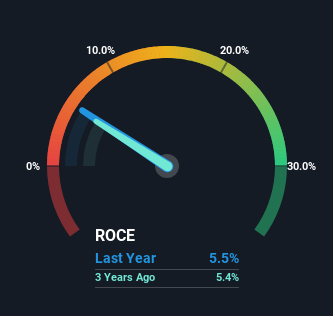- United States
- /
- Software
- /
- NYSE:NOW
We Like These Underlying Return On Capital Trends At ServiceNow (NYSE:NOW)

There are a few key trends to look for if we want to identify the next multi-bagger. Typically, we'll want to notice a trend of growing return on capital employed (ROCE) and alongside that, an expanding base of capital employed. This shows us that it's a compounding machine, able to continually reinvest its earnings back into the business and generate higher returns. So when we looked at ServiceNow (NYSE:NOW) and its trend of ROCE, we really liked what we saw.
Return On Capital Employed (ROCE): What Is It?
Just to clarify if you're unsure, ROCE is a metric for evaluating how much pre-tax income (in percentage terms) a company earns on the capital invested in its business. Analysts use this formula to calculate it for ServiceNow:
Return on Capital Employed = Earnings Before Interest and Tax (EBIT) ÷ (Total Assets - Current Liabilities)
0.055 = US$507m ÷ (US$15b - US$5.8b) (Based on the trailing twelve months to June 2023).
So, ServiceNow has an ROCE of 5.5%. In absolute terms, that's a low return and it also under-performs the Software industry average of 9.2%.
See our latest analysis for ServiceNow

Above you can see how the current ROCE for ServiceNow compares to its prior returns on capital, but there's only so much you can tell from the past. If you'd like to see what analysts are forecasting going forward, you should check out our free report for ServiceNow.
What Can We Tell From ServiceNow's ROCE Trend?
ServiceNow has recently broken into profitability so their prior investments seem to be paying off. Shareholders would no doubt be pleased with this because the business was loss-making five years ago but is is now generating 5.5% on its capital. Not only that, but the company is utilizing 460% more capital than before, but that's to be expected from a company trying to break into profitability. We like this trend, because it tells us the company has profitable reinvestment opportunities available to it, and if it continues going forward that can lead to a multi-bagger performance.
One more thing to note, ServiceNow has decreased current liabilities to 39% of total assets over this period, which effectively reduces the amount of funding from suppliers or short-term creditors. This tells us that ServiceNow has grown its returns without a reliance on increasing their current liabilities, which we're very happy with.
The Bottom Line
Long story short, we're delighted to see that ServiceNow's reinvestment activities have paid off and the company is now profitable. And a remarkable 189% total return over the last five years tells us that investors are expecting more good things to come in the future. With that being said, we still think the promising fundamentals mean the company deserves some further due diligence.
If you'd like to know more about ServiceNow, we've spotted 2 warning signs, and 1 of them is potentially serious.
While ServiceNow isn't earning the highest return, check out this free list of companies that are earning high returns on equity with solid balance sheets.
New: Manage All Your Stock Portfolios in One Place
We've created the ultimate portfolio companion for stock investors, and it's free.
• Connect an unlimited number of Portfolios and see your total in one currency
• Be alerted to new Warning Signs or Risks via email or mobile
• Track the Fair Value of your stocks
Have feedback on this article? Concerned about the content? Get in touch with us directly. Alternatively, email editorial-team (at) simplywallst.com.
This article by Simply Wall St is general in nature. We provide commentary based on historical data and analyst forecasts only using an unbiased methodology and our articles are not intended to be financial advice. It does not constitute a recommendation to buy or sell any stock, and does not take account of your objectives, or your financial situation. We aim to bring you long-term focused analysis driven by fundamental data. Note that our analysis may not factor in the latest price-sensitive company announcements or qualitative material. Simply Wall St has no position in any stocks mentioned.
About NYSE:NOW
ServiceNow
Provides cloud-based solution for digital workflows in the North America, Europe, the Middle East and Africa, Asia Pacific, and internationally.
Flawless balance sheet with high growth potential.
Similar Companies
Market Insights
Community Narratives





